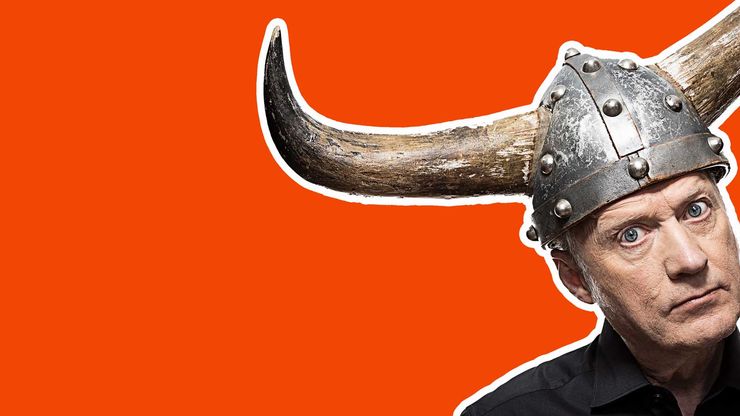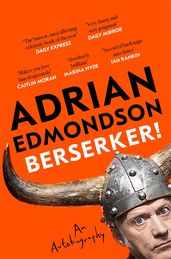“Bored. Bored. Bored. Bored! BORED!”: five ways Adrian Edmondson brought some much-needed punk to British comedy
Steve Bennett looks back at Adrian Edmondson's career, from The Comedy Store to The Young Ones and Bottom.

You might know him best as Vyvyan, or maybe Edward, but as the title of his new book makes clear, Adrian Edmondson wants you to know that really, he's a Berserker. . . To celebrate the release of the game-changing comedian's autobiography, comedy journalist and editor Steve Bennett explains why Adrian Edmondson has been such an influential force in British comedy.
Britain’s live comedy scene was in a pretty uninspiring state when Adrian Edmondson started performing at Manchester University in 1976, the big stars of the day all drawing on the same shallow pool of gags involving dim Irishmen or nagging mothers-in-law. Edmondson, and others like him, were to change all that forever.
He was at a drama seminar when he was approached by course-mate Rik Mayall and asked to join a small comedy troupe called 20th Century Coyote performing anarchic, improvised skits locally – and subsequently at the Edinburgh Fringe. Eventually the group became just the pair of them, and, via high energy performances, Enid Blyton parodies and a healthy dose of slapstick, they joined the vanguard of a new wave of disruptive talent.
Here are five ways Adrian Edmondson brought some much-needed punk sensibilities to the staid comedy circuit.
The Dangerous Brothers
In 1979, entrepreneurs Peter Rosengard and Don Ward opened a new type of comedy club in London, inspired by similar ventures they had seen in America: The Comedy Store. Originally operating in a Soho strip club, it welcomed anyone to take to the stage – at the risk of being gonged off if the rowdy late-night bearpit audience did not approve.
Early gigs were chaotic, saved only by the powerhouse hosting of Alexei Sayle, the only act who made any sort of an impact at auditions. But within a few months, talented regulars started to emerge, including a cohort of political stand-ups plus two double acts: The Outer Limits – comprising Peter Richardson and Nigel Planer – and 20th Century Coyote.
‘Crucially, their high-energy, fast-talking and violently unhinged style was impervious to the interruptions of the well-lubricated crowd.’
At the Store, Rik and Ade refined an act called The Dangerous Brothers, bickering siblings introducing a risky stunt they never got around to performing. Crucially, their high-energy, fast-talking and violently unhinged style – which would come to define much of their work for the next decades – was impervious to the interruptions of the well-lubricated crowd.
Among those who attended the Store was a BBC producer called Paul Jackson, who managed to persuade his bosses there was an exciting alternative cabaret scene emerging that ought to be showcased on TV. The result was a show called Boom Boom. . .Out Go the Lights. Edmondson didn’t appear in the pilot, but 20th Century Coyote careered their way onto the full series in 1981.
Five Go Mad on Channel 4
Having moved from The Comedy Store to set up The Comic Strip (in another strip club, The Raymond Revue Bar) and expanded to include dour Scottish stand-up Arnold Brown and another double act, Dawn French and Jennifer Saunders, Richardson successfully pitched the new troupe to soon-to-launch TV station, Channel 4. The first in The Comic Strip Presents series, Enid Blyton parody Five Go Mad in Dorset, aired on the channel’s opening night, November 2, 1982, with Edmondson playing Dick, and helped establish the upstart channel as a home for a fresh wave of talent exercising their creativity.
“Completely revolting”: The Young Ones
Written by Ben Elton, Rik Mayall and Lise Mayer and directed by Jackson, The Young Ones brought alternative comedy to the mainstream.
Set in a filthy student houseshare, Mayall would be ‘Rik’, a version of the naive, earnest liberal would-be poet he played on the circuit; Ade would be the violent, fearless punk Vyvyan Basterd, loosely based on his Dangerous Brothers alter-ego; Planer would be the hippy Neil; and Christopher Ryan would be Mike, a cool wide-boy character – between them representing youth subcultures from the 1980s, 1970s, 1960s and 1950s respectively.
‘Traditional sitcom norms were upended. . . The Young Ones delighted its young audience and baffled the older generation. Alternative comedy was here to stay.’
Traditional sitcom norms were upended – as explicitly shown when Vyvyan literally burst through the opening titles of the cosy comedy The Good Life yelling: "No, no, we’re not watching the bloody Good Life… I hate it, it’s so bloody nice!"
That was typical of the aggressive slapstick, random plot turns and surreal skits – such as Vyvyan’s talking hamster Special Patrol Group, or the character literally losing his head in a train accident – that delighted its young audience and baffled the older generation. Alternative comedy was here to stay.
Saturday Live
Though its influence was huge, The Young Ones only ran for two series. Just as important in spreading the word about the new form of comedy was Channel 4’s Saturday Live – subsequently Friday Night Live after a schedule change – which ran for four series from 1985.
This widened the pool of comedians being introduced to the viewing world, with a host of household names getting their break on the show: Ben Elton, Harry Enfield, Stephen Fry. Hugh Laurie, Jo Brand, Julian Clary and more.
Rik and Ade were regulars throughout the first series, presenting a new Dangerous Brothers sketch every week and thrusting them even further into the public consciousness.
Bottom
Video contains strong language
Bottom, which ran for three series from 1991, starred Rik and Ade as two sordid bachelors living in a grimy flat in West London, and continued the violent squalor of their double-act relationship, but leant even harder into crude jokes and mad slapstick. Though it made no claims to have any message nor morality, some critics thought it was a savage criticism of how society treated the vulnerable left behind by capitalism. But mainly it was two grown men belting each other with frying pans.
It was so successful it spawned five nationwide tours, running until 2003, and a movie, Guest House Paradiso, loosely based on the same characters, but intended as a standalone.
Hear more from the berserker himself
Berserker!
by Adrian Edmondson
Ade Edmondson smashed onto the comedy circuit in the 1980s and brought anarchy to stage and screen. How did a child brought up in a strict Methodist household – and who spent his formative years incarcerated in repressive boarding schools – end up joining the revolution? Well, he is part Norse. Could it be his ‘berserker’ heritage? With wisdom, nostalgia and uniquely observed humour, Ade traces his journey through life and comedy: starting out on the alternative scene, getting arrested in Soho, creating his outrageously violent characters and learning more about his curious (possibly Scandinavian) heritage. With star-studded anecdotes and set to a soundtrack of pop hits which transport the reader through time, it’s a memoir like no other.



